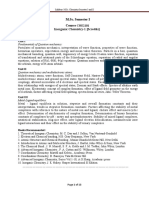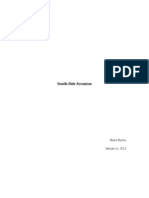S 482
S 482
Uploaded by
Vikas RajpootCopyright:
Available Formats
S 482
S 482
Uploaded by
Vikas RajpootOriginal Description:
Original Title
Copyright
Available Formats
Share this document
Did you find this document useful?
Is this content inappropriate?
Copyright:
Available Formats
S 482
S 482
Uploaded by
Vikas RajpootCopyright:
Available Formats
S-482 (R-13)
Institute for Excellence in Higher Education (IEHE), Bhopal
B.Sc. (HONOURS): PART-II Semester: IV
SUBJECT: CHEMISTRY PAPER: HONOURS - II
TITLE: Inorganic Chemistry-II
Maximum Marks: 100
SYLLABUS
1. Chemistry of First Transition Series:
Characteristic Properties of d-Block Elements, Properties of Elements of First
Transition Series, their Binary Compounds and Complexes illustrating Relative
Stability of their Oxidation States, Coordination Number and Geometry.
2. Chemistry of Second and Third Transition Series:
General Characteristics, Comparative Treatment with their 3d analogues in respect
of – Ionic Radii, Oxidation States, Magnetic behavior and Spectral Properties and
Sterio-chemistry.
3. Coordination Compounds:
Werner’s Coordination Theory and its Experimental Verification, Effective
Atomic Number Concept, Chelates, Nomenclature of Coordination Compounds,
Isomerism in Coordination Compounds, VBT of Transition Metal Complexes.
Biological Role of Coordination Compounds-Haemoglobin and Myoglobin.
4. Metal Ligand Bonding in Transition Metal Complexes:
Limitation of VBT and Elementary idea of CFT, Crystal Field Splitting in
Octahedral, Tetrahedral and Square Planar Complexes, Factors Affecting Crystal
Field Parameters.
5. Magnetic Properties of Transition Metal Complexes:
Types of Magnetic Behaviour, Methods of Determining magnetic Susceptibility,
Spin only Formula, L-S Coupling, Correlation of µs and µexp values, Orbital
Contribution to Magnetic Moments, Application of Magnetic Moment Data for 3d
Metal Complexes.
6. Electronic Spectra of Transition Metal Complexes:
Types of Electronic Transitions, Selection Rules for d-d transition, Spectroscopic
Ground States, Spectro-chemical Series. Orgel Energy Level Diagram for d1 to d 9
states, Discussion of Electronic Spectrum of [Ti(H2O)6]3+ Complex Ion.
Approved for the session 2019-20 Page 1 of 2
S-482 (R-13)
7. Thermodynamics and Kinetic Aspects of Metal Complexes:
A Brief Outline of Thermodynamic Stability of Metal Complexes and Factors
affecting stability, Substitution Reaction of Square Planar Complexes.
8. Chemistry of Lanthanide Elements:
Electronic Structure, Oxidation State and Ionic Radii and Lanthanide contraction.
Complex Formation, Occurrence and Isolation of Lanthanides.
9. Chemistry of Actinides:
General Features and Chemistry of Actinides, Chemistry of Separation of Np, Pu,
Am from U, Similarities between later Actinides and later Lanthanides.
10. Organometallic Chemistry:
A Brief Account of Metal-ethylene Complexes and Homogeneous Hydrogenation,
Mononuclear Carbonyls and Nature of Bonding in Metal Carbonyls.
Reference Books:
1. Gurdeep Raj, Inorganic Chemistry, Krishna Publication
2. Malik Waheed, Inorganic Chemistry, S. Chand Publication
3. Madan R.D., Modern Inorganic Chemistry, S. Chand Publication
4. Satya Prakash, Advanced Inorganic Chemistry, S. Chand Publication
5. Lee J.D., Concise Inorganic Chemistry, Blackwell Publication
6. Huheey James, Inorganic Chemistry, Addison Wesely Publication
7. Cotton & Wilkenson, Advanced Inorganic Chemistry, Wiley John Publication
8. Malik Waheed, Selected Topic in Inorganic Chemistry, S. Chand Publication.
Approved for the session 2019-20 Page 2 of 2
You might also like
- Art Appreciation Book Final Pub. 2018 1Document83 pagesArt Appreciation Book Final Pub. 2018 1한서린86% (173)
- Helen in Egypt - Hilda DoolittleDocument231 pagesHelen in Egypt - Hilda DoolittleJavier Galarza100% (5)
- Ayckbourn Absurd Person SingularDocument28 pagesAyckbourn Absurd Person SingularSaheli Gupta0% (1)
- Collection of Masses of The Blessed Virgin MaryDocument27 pagesCollection of Masses of The Blessed Virgin MaryDarryl Reyes100% (1)
- Across The StarsDocument25 pagesAcross The StarsCrf Rios100% (2)
- MIL-STD-22D Welded Joint DesignDocument81 pagesMIL-STD-22D Welded Joint DesignGarth SandersNo ratings yet
- Digital Booklet - From Under The Cork Tree PDFDocument3 pagesDigital Booklet - From Under The Cork Tree PDFAngga PrasetyoNo ratings yet
- Engineering Chemistry Theory 2020-21Document168 pagesEngineering Chemistry Theory 2020-21architabarmanroyNo ratings yet
- 5 D1 Teaching Plan ChemistryDocument3 pages5 D1 Teaching Plan ChemistrySikander GirgoukarNo ratings yet
- Syllabus 4th Major J2Document3 pagesSyllabus 4th Major J2Dr. Oyais Ahmad ChatNo ratings yet
- Cluster University Srinagar: Chemistry Semester - I (Credits: Theory-4, Practicals-2) TheoryDocument3 pagesCluster University Srinagar: Chemistry Semester - I (Credits: Theory-4, Practicals-2) TheoryCool for the AnimeNo ratings yet
- Chemistry Final6Document4 pagesChemistry Final6MohitNo ratings yet
- Student 61Document13 pagesStudent 61ykritika639No ratings yet
- Compressed MSC SyllabusDocument22 pagesCompressed MSC Syllabuspriyanka dasNo ratings yet
- F - Y - B - SC - MDC in - NEP FormatDocument4 pagesF - Y - B - SC - MDC in - NEP Formatjustshivansh2No ratings yet
- MScSem1 2 ChemistrySyllabusDocument13 pagesMScSem1 2 ChemistrySyllabusYuv RajNo ratings yet
- Sfbrwjmnyteu, K R 9 U 8 0'weq 2Document23 pagesSfbrwjmnyteu, K R 9 U 8 0'weq 2StephenNo ratings yet
- MSC Syllabus AllDocument13 pagesMSC Syllabus AllOmSilence2651No ratings yet
- 1-M.Sc. (Previous) Chemistry Syllabus and Model Papers 2021-2022Document32 pages1-M.Sc. (Previous) Chemistry Syllabus and Model Papers 2021-2022Balakrishna GantaNo ratings yet
- Inorganic ChemistryDocument1 pageInorganic ChemistryMarcusNo ratings yet
- FM University Chemistry SyllabusDocument4 pagesFM University Chemistry SyllabusGayatree TripathyNo ratings yet
- CBCS - B.sc. With Chemistry - Generic ElectiveDocument17 pagesCBCS - B.sc. With Chemistry - Generic ElectiveMd RaselNo ratings yet
- Maulana Abul Kalam Azad University of Technology, West Bengal 1 Year Curriculum Structure For B.Tech Courses in Engineering & TechnologyDocument2 pagesMaulana Abul Kalam Azad University of Technology, West Bengal 1 Year Curriculum Structure For B.Tech Courses in Engineering & Technologyanushaghosh2003No ratings yet
- Unit-I Chemical Bonding and Molecular Structure: (18 Contact Hours)Document3 pagesUnit-I Chemical Bonding and Molecular Structure: (18 Contact Hours)Imran Afzal BhatNo ratings yet
- 150Document6 pages150Oyais AhmadNo ratings yet
- Institute For Excellence in Higher Education (IEHE), Bhopal: B.Sc. (Honours) : SemesterDocument2 pagesInstitute For Excellence in Higher Education (IEHE), Bhopal: B.Sc. (Honours) : SemesterMerlyn SylvesterNo ratings yet
- Documents Syllabus ChemistryDocument6 pagesDocuments Syllabus ChemistryAnu ShreeeNo ratings yet
- B.Sc. Chemistry (With Physics/ Life Sciences)Document31 pagesB.Sc. Chemistry (With Physics/ Life Sciences)Gaming SisbroNo ratings yet
- 72 - GDR B.sc. Syallbus PDFDocument30 pages72 - GDR B.sc. Syallbus PDFTitikshaNo ratings yet
- Inorganic Chemistry (Paper Code - CH-101) : B.SC 1st Year (Sem. 1st)Document18 pagesInorganic Chemistry (Paper Code - CH-101) : B.SC 1st Year (Sem. 1st)nicolezerrudo19No ratings yet
- UG ChemistryDocument24 pagesUG ChemistryPrakhar SaxenaNo ratings yet
- Syllabus B.sc. Chemistry Sem I-VIDocument29 pagesSyllabus B.sc. Chemistry Sem I-VIAyush KesharwaniNo ratings yet
- B SC 3rd & 4th Sem. SyllabusDocument4 pagesB SC 3rd & 4th Sem. Syllabusakbar azamNo ratings yet
- Syllabus WBPSC Assistant Master Mistress Advt No.15 2015Document19 pagesSyllabus WBPSC Assistant Master Mistress Advt No.15 2015sudipkunduchem1178No ratings yet
- 2606 - 763 - Chemistry I, Ii, Iii 2020-21Document23 pages2606 - 763 - Chemistry I, Ii, Iii 2020-21ubaid siddiquiNo ratings yet
- Final PG SyllabusDocument34 pagesFinal PG SyllabushhhskumNo ratings yet
- B.SC Chemistry Syllabus PDFDocument49 pagesB.SC Chemistry Syllabus PDFDIKSHA SARASWATNo ratings yet
- BSC Chemistry 6th Sem Paper-1 Inorganic ChemistryDocument138 pagesBSC Chemistry 6th Sem Paper-1 Inorganic ChemistrySEBAGGALA YUNUSNo ratings yet
- Inorganic Chemistry Semester VI Paper 10 Max Marks: 100 (80 + 20) Unit - IDocument1 pageInorganic Chemistry Semester VI Paper 10 Max Marks: 100 (80 + 20) Unit - IRuchi SaxenaNo ratings yet
- Jee-Main Extra Syllabus For Exam Junior & Senior - Total - Topics-2Document3 pagesJee-Main Extra Syllabus For Exam Junior & Senior - Total - Topics-2Hemanth MindhiNo ratings yet
- Coordination Chemistry1Document50 pagesCoordination Chemistry1ViejayNo ratings yet
- M.SC ChemistryDocument41 pagesM.SC ChemistryvishnuNo ratings yet
- P Institute For Excellence in Higher Education (IEHE), BhopalDocument3 pagesP Institute For Excellence in Higher Education (IEHE), BhopalVikas RajpootNo ratings yet
- M.SC - Sem-I Paper I Inorganic FINALDocument5 pagesM.SC - Sem-I Paper I Inorganic FINALNIMESHKAMDARNo ratings yet
- Chemistry Study Materials - BSCCH202Document49 pagesChemistry Study Materials - BSCCH202dipankargh48No ratings yet
- B. TECH Minor Course Indian School of Mines, DhanbadDocument6 pagesB. TECH Minor Course Indian School of Mines, DhanbaddikshaNo ratings yet
- JUT Syllabus Chemistry-I Bit SindriDocument4 pagesJUT Syllabus Chemistry-I Bit SindriPalNo ratings yet
- Chemical Dynamics & Coordination ChemistryDocument3 pagesChemical Dynamics & Coordination Chemistryshivam dubeyNo ratings yet
- FYBSC ChemistryDocument13 pagesFYBSC Chemistryhitech cityNo ratings yet
- 2nd Semester M.SC SyllabusDocument7 pages2nd Semester M.SC SyllabusMahendra Kumar H SNo ratings yet
- U.P. Higher Education Services Commission, Allahabd ChemistryDocument4 pagesU.P. Higher Education Services Commission, Allahabd ChemistryAnupam AwasthiNo ratings yet
- Section - C: CHEMISTRYDocument8 pagesSection - C: CHEMISTRYVimala PeethalaNo ratings yet
- Ele Final Syl BtechDocument38 pagesEle Final Syl BtechBIRRU JEEVAN KUMARNo ratings yet
- 4.41 T. Y. B.SC - Inorganic Chemistry 6 Units Sem V1Document10 pages4.41 T. Y. B.SC - Inorganic Chemistry 6 Units Sem V1sanjay sNo ratings yet
- B.Sc. (Hons.) Science / Life Sciences / Home Science: (A) EnglishDocument15 pagesB.Sc. (Hons.) Science / Life Sciences / Home Science: (A) Englishshadab ansariNo ratings yet
- Inorganic Chemistry and Group Chemistry Unit 1: Electronic Properties and Band Theory Lecture 1: IntroductionDocument4 pagesInorganic Chemistry and Group Chemistry Unit 1: Electronic Properties and Band Theory Lecture 1: IntroductionGururaj KjNo ratings yet
- Inorganic Chemistry and Group Chemistry Unit 1: Electronic Properties and Band Theory Lecture 1: IntroductionDocument4 pagesInorganic Chemistry and Group Chemistry Unit 1: Electronic Properties and Band Theory Lecture 1: IntroductionGururaj KjNo ratings yet
- Inorganic Chemistry and Group Chemistry Unit 1: Electronic Properties and Band Theory Lecture 1: IntroductionDocument4 pagesInorganic Chemistry and Group Chemistry Unit 1: Electronic Properties and Band Theory Lecture 1: IntroductionGururaj KjNo ratings yet
- Inorganic Chemistry and Group Chemistry Unit 1: Electronic Properties and Band Theory Lecture 1: IntroductionDocument4 pagesInorganic Chemistry and Group Chemistry Unit 1: Electronic Properties and Band Theory Lecture 1: IntroductionGururaj KjNo ratings yet
- BTECH Syllabus-1Document31 pagesBTECH Syllabus-1AJIT PRASAD 12- C. Roll-04No ratings yet
- UG SyllabusDocument286 pagesUG SyllabusasajaydudeNo ratings yet
- Appgcet2024 Chemical SciencesDocument9 pagesAppgcet2024 Chemical SciencesMaheshNo ratings yet
- Electronic Spectra of Transition Metal ComplexesDocument10 pagesElectronic Spectra of Transition Metal Complexesgajendra singhNo ratings yet
- Engineering Chemistry: Hitec University, Taxila Cantt Department of Mechanical EngineeringDocument3 pagesEngineering Chemistry: Hitec University, Taxila Cantt Department of Mechanical EngineeringM Zeeshan HaiderNo ratings yet
- Chemistry FileDocument41 pagesChemistry FilePreetiNo ratings yet
- Ferneyhough - Etudes Transcendantales 5 A 9 PDFDocument38 pagesFerneyhough - Etudes Transcendantales 5 A 9 PDFDavid CsizmadiaNo ratings yet
- The Art of BionicleDocument57 pagesThe Art of Bioniclegeorge67% (3)
- Immortal Millennium Book of WarDocument97 pagesImmortal Millennium Book of Warburningbright100% (2)
- Worksheets Family PDFDocument2 pagesWorksheets Family PDFmbozcute100% (1)
- Scranton ProjectDocument9 pagesScranton ProjectBlaire Fallon ByrleyNo ratings yet
- My Chosen Artist: Ariana Grande: Task 3 - Music Video Case StudyDocument12 pagesMy Chosen Artist: Ariana Grande: Task 3 - Music Video Case StudyLizzyNo ratings yet
- Ucun Bahasa Inggris Paket ADocument9 pagesUcun Bahasa Inggris Paket AKe TrinNo ratings yet
- Californication ActivityDocument2 pagesCalifornication ActivityJoão Guilherme VianaNo ratings yet
- Specialty Fine Powders and ExfoliantsDocument20 pagesSpecialty Fine Powders and ExfoliantsAPEX SONNo ratings yet
- Idries Shah BiographyDocument27 pagesIdries Shah BiographyCidCarmo100% (1)
- POULENC 2010BhardwajK - Thesis PDFDocument92 pagesPOULENC 2010BhardwajK - Thesis PDFAngelo MartinNo ratings yet
- Profile of The Queen ElizabethDocument2 pagesProfile of The Queen Elizabethruchita1989No ratings yet
- Chance Brothers Limited Friends TalkDocument23 pagesChance Brothers Limited Friends Talklauralbrett100% (1)
- Tartaria TabletsDocument7 pagesTartaria TabletsGernelda ThudpuckettNo ratings yet
- Wood and Steel - Spring - 2011Document36 pagesWood and Steel - Spring - 2011waystar100% (1)
- Scanpro 3000 User ManualDocument15 pagesScanpro 3000 User Manualxyc321No ratings yet
- Knauf Ceiling Tiles BrochureDocument8 pagesKnauf Ceiling Tiles BrochureAmin ChhipaNo ratings yet
- Case Study: 5 Star Hotel Noor MahalDocument18 pagesCase Study: 5 Star Hotel Noor MahalnikitaNo ratings yet
- Shanti of Mr. Sampath and Rangi of The Man Easter of Malgudi Add Spice To The Novels ofDocument4 pagesShanti of Mr. Sampath and Rangi of The Man Easter of Malgudi Add Spice To The Novels ofIshani BanerjeeNo ratings yet
- UntitledDocument16 pagesUntitledapi-157074529No ratings yet
- Nacimiento Del Mesias YeshuaDocument6 pagesNacimiento Del Mesias YeshuaLuis FernandezNo ratings yet
- Romans 4 17 25 How Can I Accomplish God S Will in My LifeDocument2 pagesRomans 4 17 25 How Can I Accomplish God S Will in My LifeCabagnot Piolo JuliusNo ratings yet
- JoA CORE Rulebook ENG v13 PDFDocument36 pagesJoA CORE Rulebook ENG v13 PDFBob Sa0% (1)

























































































